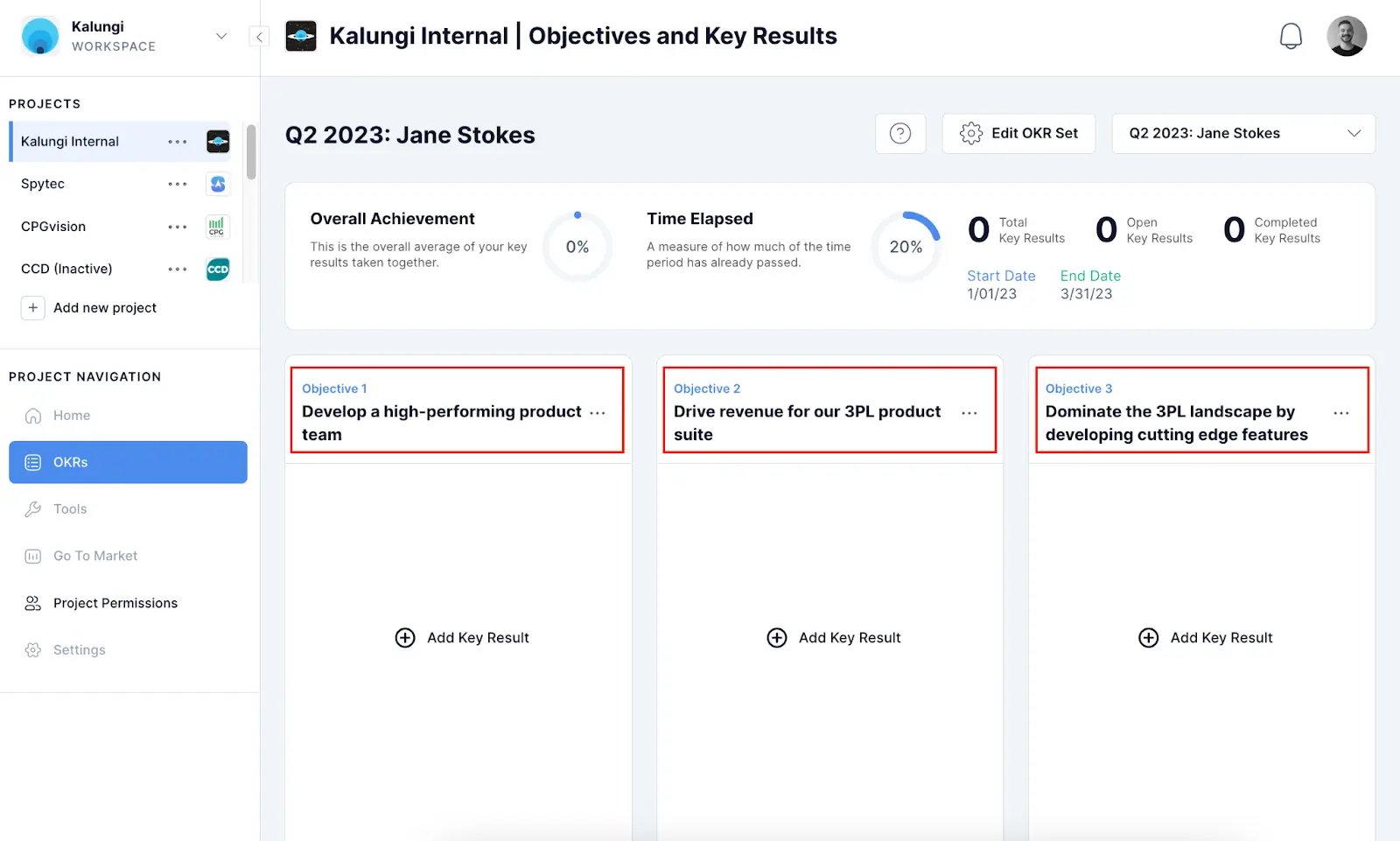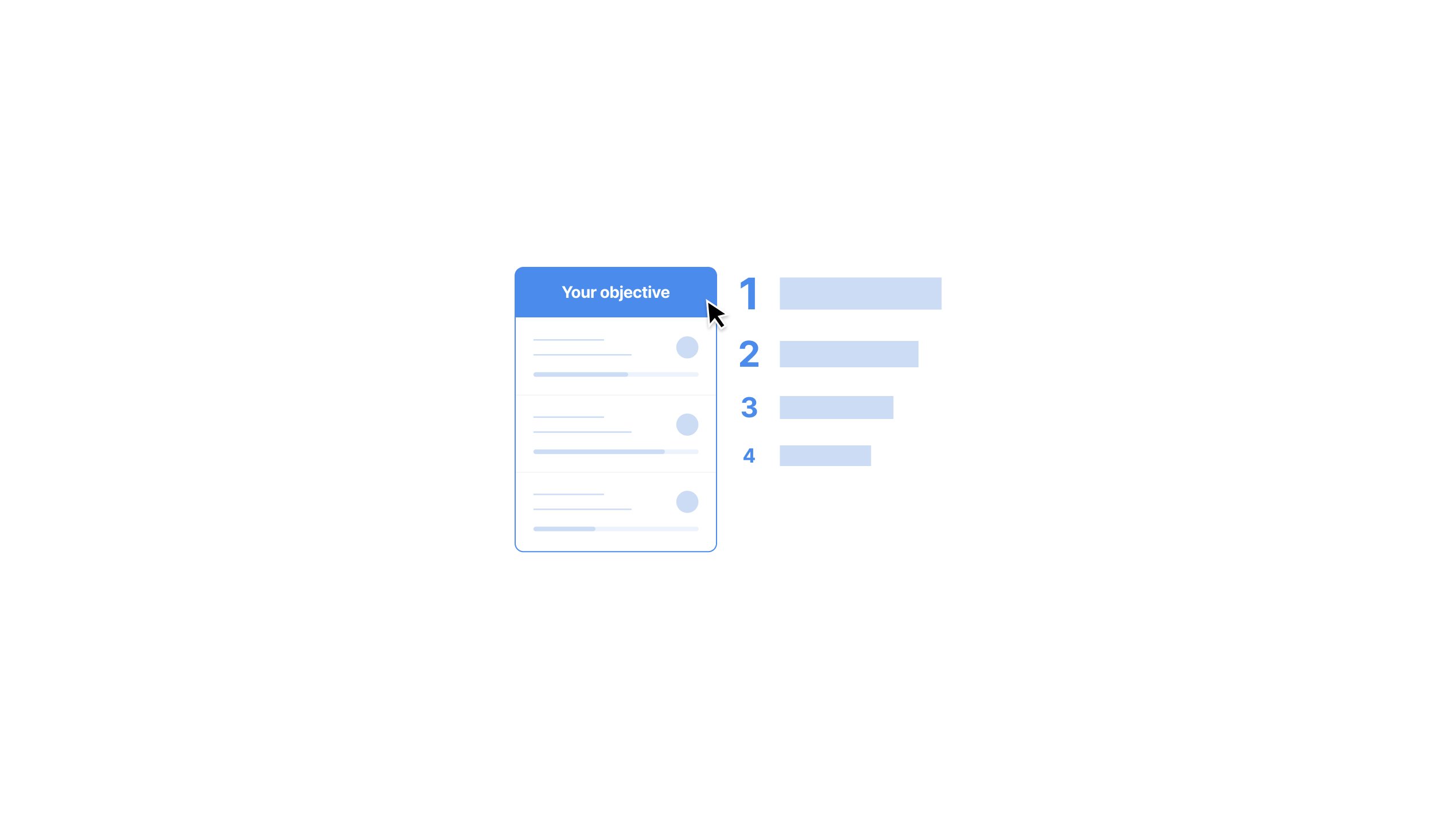When setting goals, it’s easy to hyperfocus on specific numbers, deliverables, and other quantifiable measures of success. These “key results” are essential to a successful set of goals as they allow you to definitively point to your achievements and say whether you performed well against or fell short of your expectations. These key results, however, are only a means to an end. Knowing what ends you hope to achieve should be your first step in creating your objectives and key results (OKRs) for the quarter.
Rather than building your goals around how much growth you hope to see in the pipeline or by how many new blogs you want to drive your team to produce, work from the top down. First, define what overarching goals you will be working towards that quarter. Growing your team? Building revenue? Expanding your offering? Use these “objectives” as the guidelines by which you pick the results that will define your success.
In a standard OKR framework, like that used in the Kalungi App, the objectives will sit over and guide your key results, such as in the example below. Define and place these goals, then start building downwards, placing key results beneath each.

You could take these objectives in many different directions, but here we’ll go over four central ones which we recommend as a good, general starting place.
Grow as a contributor
As the quarter progresses, it's easy to put personal growth and development on the back burner as new projects, opportunities, and requests arise. If you find that you never seem to have time to take those online courses, build your professional brand, collect and act on team feedback, or work on any other tasks that contribute most significantly to your own growth as a contributor then highlighting them on your OKRs can be a great opportunity to make them a priority.
Having this type of objective in your personal OKRs is particularly useful when you are new to a position, transitioning roles, or need to quickly pick up new skills in that particular quarter.
Here are a few examples of potential key results for this objective type:
- Become T2D3 certified by passing the T2D3 Foundations Certification exam
- Receive 10 responses to a feedback survey on personal performance
- Improve average score on feedback survey responses by 3 points
- Read 3 books on B2B sales best practices and methodology
- Attend three SaaS conferences and events
Build and support a strong team and grow as a leader
Goals in this section should focus on how you can expand and strengthen your team and help them achieve their own goals. To start getting ideas, speak with your team to get feedback on where they could use your help that quarter. You can also use any feedback you’ve collected from team surveys to find areas where you have room for growth as a leader.
Here are a few examples of potential key results for this objective type:
- Hire a new product marketing leader
- Support team to publish six articles to the company blog
- Help [team member] to independently lead three executive syncs
- Hold 30 1:1s with team members throughout the quarter
Consider putting key results from your team’s OKRs on your own under this objective, with the intent to support them in their goal. This practice is often called “cascading OKRs.” While it can operate well on a small scale, some consider it a poor practice at a large scale.
Create new and develop existing content, products, and services
While the two objective examples we’ve covered so far have focused primarily on personal and team growth, this objective focuses on the production of your deliverables. Here you will aim to expand your current offerings, create new ones, and generate content and materials to support them.
When possible, you’ll want your key results across all objective categories to focus less on actions and more on their results. However, in some cases, you may not be able to accurately predict the results of your work, or the results will simply not be seen in the time frame of your OKRs. You can then instead focus on the work and deliverables themselves.
Here are a few examples of potential key results for this objective type:
- Develop third-party integration with Stripe
- Produce 3 demand generation blogs
- Publish 2 new downloadable templates
- 100 active users signed up to new dashboard module
- Data export capability live for all enterprise plan users
Driving revenue and growth
Our final recommended objective category is perhaps the most important as it revolves around your team and company’s bottom-line goals: revenue and growth.
These goals should be achieved by progress and success on your most important projects of the year. They are the reason why you will be working on and prioritizing your focus deliverables for the quarter. Ideally, your success in all your other key results and objectives should result in your success here.
When assembling your OKRs for the quarter, consider starting by creating key results for this objective first and then working backward to determine how your other objectives and results can support them.
Here are a few examples of potential key results for this objective type:
- $200,000 in revenue from new dashboard subscription sales
- 15 4+ star reviews on product review sites
- 3 partners onboarded to sales partnership program
- Reduce monthly churn rate by 25%
- Sell first package subscription to non-US company
Picking your objectives and kicking off your OKRs
Hopefully these basic objective structures are enough to help guide you through the formation of your next quarter’s OKRs. Picking a set of objectives that you keep consistent throughout multiple quarters, even as their key results change, can be a great way to measure your progress on these overarching goals. Which of these objective types is most important for your current responsibilities can vary quarter to quarter or year to year, so it’s important to revisit, tweak, or swap them each time you’re creating a new set of OKRs.
Because we’ve found this approach to work best for SaaS companies, we developed the Kalungi App’s OKR tool around this structure, where each goal you build is organized under an objective.
.webp?width=332&height=590&name=okrs%20objective%20with%20key%20results%20for%20saas%20marketing%20team%20(1).webp)
If you’re laying out your goals for the upcoming quarter, use the Kalungi App’s OKR framework. After building hundreds of OKR sets for SaaS companies, we found visibility, accessibility, and ownership to be crucial to building goals that actually get done. That’s why we built our own OKR tool with these key features in mind. Try it free for 14 days.
If you’re looking for more examples of possible objectives and key results and more information on building successful OKRs, see the blog here.
